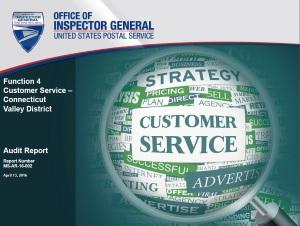Function 4 Customer Service-Connecticut Valley District
Background
As part of its ongoing effort to provide cost-effective, high-quality customer service, the U.S. Postal Service tracks customer service activities at post offices, stations, and branches. These activities are known as Function 4 operations and include Post Office boxes, retail windows, vending equipment; and miscellaneous administrative and mail forwarding operations, as well as scanning incoming mail and distributing it to carriers.
In March 2010, the Postal Service unveiled a comprehensive action plan for the next decade to increase efficiency and manage costs. In line with this plan, the Postal Service uses a customer service variance (CSV) model to monitor retail customer service productivity at select retail facilities.
The CSV model uses actual labor workhours from the Time and Attendance Collection System, mail volume manually entered daily by unit management, and target productivity goals to determine the target workhours for a given activity. The CSV model compares target to actual workhours. If actual workhours exceed the target, the excess workhours are attributed to inefficient operations.
The U.S. Postal Service Office of Inspector General’s (OIG) Retail Customer Service risk model identified the Connecticut Valley as a high-risk district for the last 2 fiscal years.
Our objective was to assess Function 4 operations for efficiency and customer service in the Connecticut Valley District. We focused on the 330 district post offices with delivery operations that were monitored using the CSV model. During fiscal year (FY) 2015, 113 of these offices (34 percent) were considered at risk, with 611,761 actual workhours attributed to inefficient operations.
What the OIG Found
The Connecticut Valley District could improve customer service and efficiency in Function 4 operations. Specifically, for the eight facilities we visited:
- One unit scanned undelivered packages as delivered and seven units did not perform all required scans on packages.
- Two units did not safeguard accountable mail items.
- All units received mail from the plants that was late and required rework because it was not properly prepared, increasing Function 4 clerk workhours.
- Five units did not use the required software variance models to manage clerk workhours and workload and one unit entered estimated information into the models instead of measuring mail volume.
- Three units did not follow efficient mail processing procedures.
- One unit experienced equipment-related inefficiencies.
- The workroom floor was not efficiently arranged at three units.
These conditions occurred because the district did not monitor and coordinate mail arrival activities between delivery units and plants and supervisors, and their employees did not follow required procedures. In addition, clerks duplicated efforts due to scanning equipment constraints and the workroom floor was not always arranged in an efficient manner due to space constraints, which increased Function 4 actual workhours.
When the district and units do not use required staffing tools or follow prescribed procedures, the Postal Service is likely to experience operational inefficiencies that increase costs and negatively impact customer service. During FY 2015, employees at the eight units we visited had 94,571 more workhours than the target, costing the Postal Service an estimated $3.9 million.
What the OIG Recommended
We recommended management instruct unit employees to follow required scanning procedures and secure accountable items; and monitor and coordinate mail arrival plans, profiles, and quality. We also recommended management instruct customer service supervisors to use the customer service variance model and emphasize the importance of entering accurate mail volume, eliminate inefficient office practices, assess equipment needs and examine facility workroom space layout and use.

